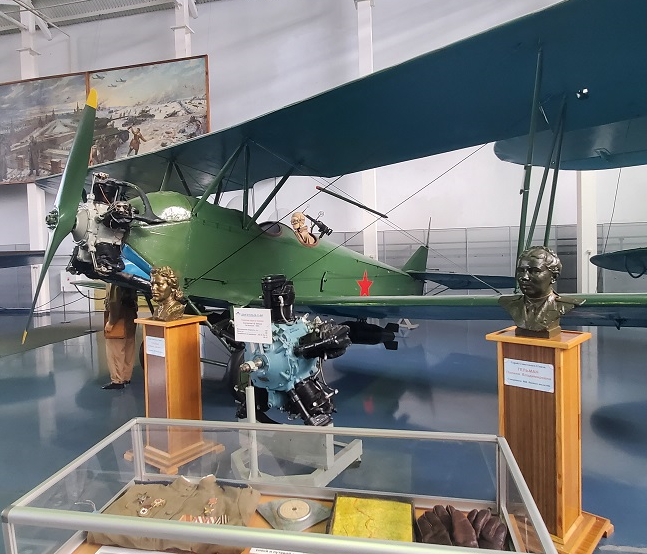PO-2 Biplane History
PO-2 or Po-2 (Polikarpov-2) is a Soviet multi -purpose biplane, created in 1927 under the leadership of N. N. Polikarpov.
One of the most massive aircraft in the world. It was built in series until 1953, 33,000 cars were built. Renamed Po-2 in honor of its creator in 1944 after the death of N. N. Polikarpov. The popular nickname “Corn” this aircraft received for its active use in agriculture.
From 1919, the main training aircraft in the RSFSR was the U-1, created on the basis of the British intelligence officer Avro-504, the first flight of which took place as early as 1913. By 1922, the question arose of the need to develop a more modern training machine, especially since by that time the methodology for teaching flying had undergone significant changes. It was recognized as necessary to carry out training in independent flights on initial training aircraft, and to polish skills on training (transitional) machines.
Nikolai Nikolaevich Polikarpov directly engaged in the development of training aircraft in 1923. One of his first works in this direction was the project of a two-seat small training aircraft with an 18 hp ABC engine. With. The car was a cantilever monoplane of pure forms with a maximum flight speed of up to 107 km / h. However, the low power of the engine did not allow training in aerobatics. The project was not implemented.
In October 1924, the Air Force Scientific and Technical Committee drew up general tactical and technical requirements for initial training and transitional aircraft. The desire to have such a biplane with a low landing speed was emphasized.
Under these requirements, Polikarpov in 1925 designed the 2U-B3 – the second training aircraft with a liquid-cooled BMW-3 engine with a capacity of 185 hp. With. It was possible to install a BMW-IV engine with 240 hp. with., then the aircraft could be considered as transitional. 2U-B3 was notable for its good aerodynamic shape and thoughtful design. Its construction was completed in February 1926, and testing began in March.
However, new requirements for initial training machines forced the aircraft to be interpreted as transitional, in connection with which it was renamed the P-1. The tests confirmed the good flight characteristics of the P-1 (2U-B3), in the flight test report, in particular, it was noted that “the spin is sluggish, reminiscent of a steep spiral.” A series of these machines was ordered, but the construction did not take place due to another change in the requirements for transitional aircraft: at the direction of P.I. as a combat training vehicle, and as a light corps reconnaissance aircraft. This is how the armed version of the P-1 with the BMW-IV engine appeared, and then the P-2 with the M-6 engine.
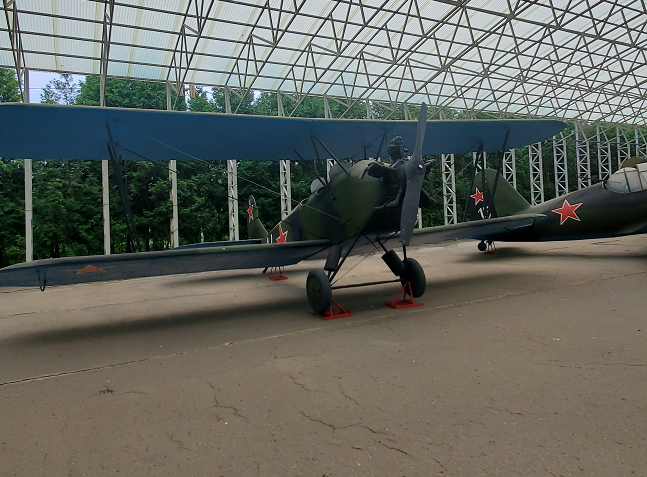 By the middle of 1925, it was decided to build an initial training aircraft with an engine with a capacity of about 100 hp. With. It was assumed that in the near future domestic design teams would be able to create such an engine. On September 27, 1925, Aviatrust informed Polikarpov by letter that “the initial training aircraft will begin to be designed by special order in connection with the construction of a new engine.” However, Polikarpov, even before this letter, completed several preliminary draft designs of this type of aircraft.
By the middle of 1925, it was decided to build an initial training aircraft with an engine with a capacity of about 100 hp. With. It was assumed that in the near future domestic design teams would be able to create such an engine. On September 27, 1925, Aviatrust informed Polikarpov by letter that “the initial training aircraft will begin to be designed by special order in connection with the construction of a new engine.” However, Polikarpov, even before this letter, completed several preliminary draft designs of this type of aircraft.
By the middle of 1926, design teams led by A. D. Shvetsov (factory No. 4) and N. R. Briling (NAMI) managed to build the M-11 and M-12 motors and begin testing them. Initially, the scales leaned towards the M-12, in connection with which, on July 3, 1926, Aviatrest officially ordered to begin designing the PO-2 training aircraft for this engine. The technical requirements for the machine were formulated by the Air Force Scientific and Technical Committee and signed by the head of the aircraft section, S. V. Ilyushin, on July 15, 1926. N. N. Polikarpov himself took an active part in their development as a member of the Scientific and Technical Committee of the Air Force. The requirements, in particular, stipulated that the maximum flight speed should not exceed 120 km / h, and the landing speed should not exceed 60 km / h, the aircraft should only be of a biplane design and be built from materials available in the USSR.
During the development of the project, Polikarpov tried to place the student and instructor seats closer to the center of gravity (unlike the 2U-B3 aircraft). Particular attention was paid to the ease of piloting the aircraft. To reduce the cost of operation and production, the upper and lower wings were of the same design, providing interchangeability. The shape of the wing and plumage in plan were made rectangular to simplify production, which distinguished the first copy from all subsequent experimental and serial versions of the PO-2. This, of course, worsened aerodynamics, but due to the low (even for those times) requirements for maximum speed, it was considered acceptable.
In a report to Aviatrust, Polikarpov noted: “For the first time, operationally significant improvements were introduced in the aircraft: mobile foot control, movable seats, switchable foot and hand controls, interchangeable ailerons, elevators, etc.”
On October 6, 1926, the preliminary design was considered at a meeting of the Aviatrust Technical Council. The resolution noted that “the general direction for the design of the U2-M12 aircraft, adopted by the land department, is recognized as correct” (in those years, N. N. Polikarpov’s design bureau existed as the department of land aircraft construction of the Central Design Bureau of Aviatrest). However, it was ordered to transfer the gas tanks from the fuselage to the upper wing and take them out from under the center section. Polikarpov objected to this point, believing that such an arrangement of gas tanks would worsen the aerodynamics of the wing, but he could not do anything.
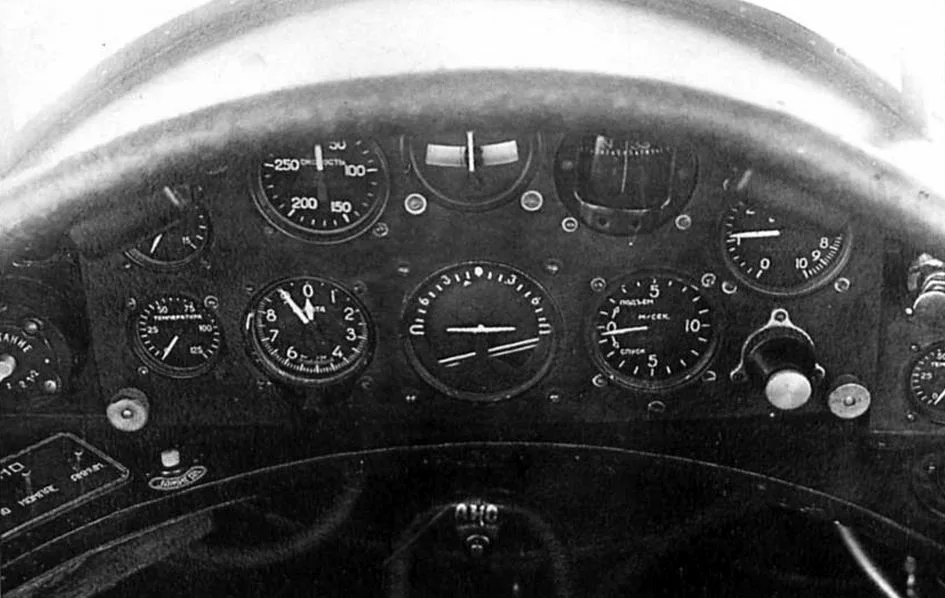 The layout of the PO-2 was built by February 5, 1927, and immediately began to build the first copy of the machine. However, there was still no complete clarity with the motor. M-12, on which the leadership of Aviatrest made the main bet, broke down on the stand. Earlier, in a resolution dated February 2, 1927, the Aviatrust Technical Council made a proposal to study the possibility of installing foreign Lucifer engines with a capacity of 100 hp on the PO-2. With. and “Salmson” in 120 l. pp., a copy of which was in the USSR in various institutions.
The layout of the PO-2 was built by February 5, 1927, and immediately began to build the first copy of the machine. However, there was still no complete clarity with the motor. M-12, on which the leadership of Aviatrest made the main bet, broke down on the stand. Earlier, in a resolution dated February 2, 1927, the Aviatrust Technical Council made a proposal to study the possibility of installing foreign Lucifer engines with a capacity of 100 hp on the PO-2. With. and “Salmson” in 120 l. pp., a copy of which was in the USSR in various institutions.
By the end of March, it turned out that the “Lucifer” that was available at the Serpukhov Aviation School was installed on a snowmobile and crashed during the run. “Salmson” in NAMI also stood on a snowmobile, worked for more than 150 hours and was thoroughly worn out. Therefore, at the end of April 1927, Aviatrest instructed to install A. D. Shvetsov on the first prototype of the M-11, which by that time had nevertheless passed bench tests, but had not passed the state ones. On June 23, 1927, the aircraft was brought to the airfield.
Tests began on June 24, 1927. Very soon it became clear that the oil overheats on the M-11 in flight, failures often occur. In fact, flight tests and refinement were carried out not so much of the aircraft as of the engine. Aviatrust gave an urgent order to install the M-12 engine on the PO-2, but they could not bring the M-12 to the proper degree of reliability. Through the joint efforts of Polikarpov and Shvetsov, many of the shortcomings of the M-11 were nevertheless eliminated. On September 15, 1927, the aircraft was handed over for state tests at the Air Force Research Institute. They showed that the machine has good flight characteristics, including spin and generally meets the requirements of the Air Force, with the exception of rate of climb. On the second copy, N. N. Polikarpov significantly improved aerodynamics by installing elliptical wingtips and plumage. The thick profile of the Prandtl-R652 wing was replaced by a thinner profile developed by the aerodynamicists of N. N. Polikarpov’s design bureau, since no suitable profile was found at TsAGI. To improve flight performance, an enlarged rudder was installed. The car was somewhat lightened to reasonable limits. Some evidence suggests that the second copy, which fully reflected Polikarpov’s views on such an aircraft, was designed simultaneously with the first, but for various reasons they decided not to transfer it to production until the testing of the first copy was completed. However, the projects were very close: the same pitch of ribs, frames, the same design of all the main elements. The draft design of the second copy was approved on February 28, 1928, after the start of testing. since TsAGI did not find a suitable profile. To improve flight performance, an enlarged rudder was installed. The car was somewhat lightened to reasonable limits. Some evidence suggests that the second copy, which fully reflected Polikarpov’s views on such an aircraft, was designed simultaneously with the first, but for various reasons they decided not to transfer it to production until the testing of the first copy was completed. However, the projects were very close: the same pitch of ribs, frames, the same design of all the main elements. The draft design of the second copy was approved on February 28, 1928, after the start of testing. since TsAGI did not find a suitable profile. To improve flight performance, an enlarged rudder was installed. The car was somewhat lightened to reasonable limits. Some evidence suggests that the second copy, which fully reflected Polikarpov’s views on such an aircraft, was designed simultaneously with the first, but for various reasons they decided not to transfer it to production until the testing of the first copy was completed. However, the projects were very close: the same pitch of ribs, frames, the same design of all the main elements. The draft design of the second copy was approved on February 28, 1928, after the start of testing. Fully reflecting Polikarpov’s views on such an aircraft, it was designed simultaneously with the first, but for various reasons they decided not to transfer it to production until the testing of the first copy was completed. However, the projects were very close: the same pitch of ribs, frames, the same design of all the main elements. The draft design of the second copy was approved on February 28, 1928, after the start of testing. Fully reflecting Polikarpov’s views on such an aircraft, it was designed simultaneously with the first, but for various reasons they decided not to transfer it to production until the testing of the first copy was completed. However, the projects were very close: the same pitch of ribs, frames, the same design of all the main elements. The draft design of the second copy was approved on February 28, 1928, after the start of testing.
The tests of the PO-2, which were carried out by the pilot M. M. Gromov from January 1928 (the first flight took place on January 7), showed the excellent flight qualities of the PO-2. On March 29, 1928, the NTK VVS decided to build an experimental PO-2 series of 6 copies at plant No. 25 for trial operation in flight schools. By October 29, 1929, this plant built 25 PO-2s, of which 19 were handed over to the customer.
In the autumn of 1928, the PO-2 and several other Soviet aircraft were exhibited at the 3rd International Aviation Exhibition in Berlin.
By the end of 1928, the tests of the experimental series were completed, after which the deployment of mass production began at the Leningrad plant No. 23. The first two PO-2s were produced by the plant in May 1929. From May to September 1929, 19 PO-2s were built. In the future, production developed very quickly. For example, only in 1933, the 23rd plant produced 1508 cars. Production aircraft differed from the second copy, mainly by a modified hood.
Aircraft description
Weight and size characteristics
- The total length of the aircraft is 8170 mm.
- Empty trainer weight:
- on wheels – 752 kg,
- skiing – 758 kg.
- Normal flying weight:
- training aircraft 1012 kg,
- bomber – 1400 kg,
- ambulance aircraft – 1472 kg.
Speed:
- maximum – from 130 to 150 km / h,
- cruising – 100-120 km / h,
- landing – 60-70 km / h.
Ceiling – 3800 m.
The range of a non-stop flight (for fuel) is 350-400 km.
Run and run – 100-150 m.
Capacities:
- gas tank – 125 l,
- oil tank – 21.5 liters.
Fuselage
The rectangular section of the fuselage is made of wood as a three-dimensional braced truss, sheathed in front with plywood, and in the back with canvas. In the sanitary modification, the PO-2 fuselage was designed for 2 seats (one recumbent and one seated), in addition, 2 people were placed on the lower wing in removable cabins designed by engineers Bakshaev or Shcherbakov.
Wing
Four wooden bearing surfaces, identical in length and area, make up a single-span wing box, braced with ribbons and I-shaped racks. The wing box is given a transverse angle of 5 degrees. The upper wing is moved forward by 800 mm.
Wingspan:
- top – 11 420 mm,
- lower – 10 655 mm.
The wing area is 35.4 m².
Tail, stabilizer, landing gear
The stabilizer and tail are removable, with an area of:
- stabilizer with rudders – 5.05 m²,
- keel with rudder – 1.67 m².
The landing gear of the aircraft is two-pillar (undercarriage with a tail support), non-retractable, with shock absorption from corded rubber.
Propeller group
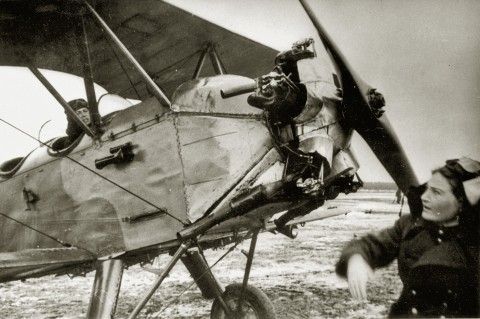
PO-2 With Female Crew
The PO-2 was equipped with a five-cylinder air-cooled M-11 engine with a maximum power of 81 to 106 kW in later modifications.
The gas tank is placed behind the firewall, the oil tank is behind the engine.
The motor starts when turning by hand or with the help of a cord shock absorber, as well as an auto starter.
Production and operation
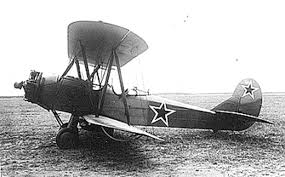
Po-2 WW2
PO-2 had a wide range of applications in agriculture, communications and other areas. There were staff, sanitary, intended for aerial photography, passenger, float and many other modifications. In 1932, a combat training version of the PO-2 (PO-2VS) was developed, which could take six 8-kilogram bombs on holders with it, and a firing point with a PV-1 machine gun was located in the rear cockpit of the vehicle.
In the 1930s, the PO-2 was produced and repaired by the Leningrad factories No. 23 and No. 47. In connection with the development of new types of aircraft by the factory No. 23, the production of the PO-2 was transferred to the new Leningrad Aviation Plant No. 387, which began to produce the PO-2 since April 1941.
With the outbreak of World War II, the existing standard PO-2 variants began to be converted into light night bombers. Refinement was carried out both at the Polikarpov Design Bureau, and at serial factories and in the army by the forces of the engineering and technical staff of combat units and aircraft repair shops. As a result, the design of the combat PO-2 had a large number of different options. The bomb load varied from 100 to 350 kg.
The relatively quiet night bomber produced, among other things, a psychological effect on the enemy. Wehrmacht soldiers called him “night sergeant major” (because he did not let him sleep at night) and “Iron Gustav”, since the archaic biplane seemed invulnerable to air defense calculations.
Also during the Great Patriotic War, the PO-2 and its modifications were produced at factories: No. 464 (Dolgoprudny ), No. 471 (Shumerlya ), No. 494 (Kozlovka ). In Moscow, at aircraft factory No. 51, modified PO-2 aircraft were built: on floats, and also special ones for conducting radio transmissions from the air.
The flight qualities of the PO-2, depending on the purpose for which the aircraft was used, and what changes were made to its equipment, varied, but in all cases the aircraft remained reliable, light and obedient in control: an increased rudder was used on the aircraft to improve flight performance. The PO-2 could take off and land at the smallest airfields and even on unprepared sites.
Price
Aircraft Po-2 (M-11D) manufactured by plant No. 464, without an engine, was sold at a price of 44,500 rubles per item (prices for the second quarter of 1945).
Aircraft modifications
- PO-2LSh – light attack aircraft; a large number of pre-war aircraft were converted to this standard; armed with one ShKAS machine gun of 7.62 mm caliber, had mounts for 120 kg of bombs plus rail guides for four RS-82 rockets.
- PO-2LNB – light night bomber, produced since 1941.
- PO-2VS – the main communications aircraft of the Soviet Air Force, was also used by senior command staff; over 9,000 examples were in service in 1945 under the new designation Po-2VS.
- PO-2 GN – “voice of the sky”.
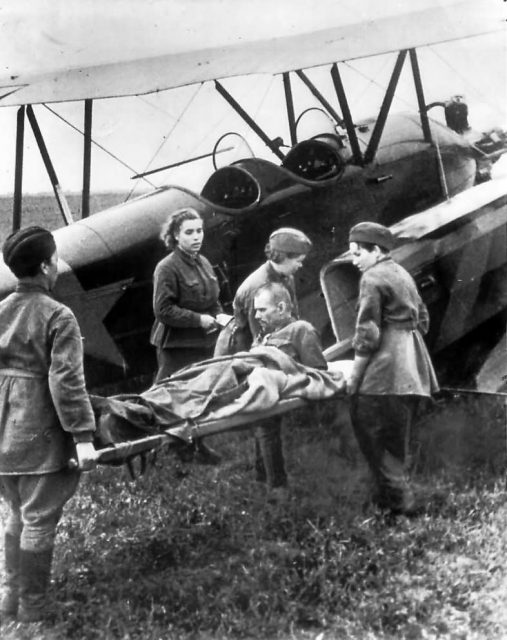
Po-2 as an Ambulance
| Crew | 2 people |
| Max Speed | 150 km/h |
| Landing speed | 65 km/h |
| practical ceiling | 3820 m |
| Range of flight | 400 km |
| Power (M-11D) | 115 l. With. |
| Fuel supply | 90 kg |
| Aircraft length | 8.17 m |
| Aircraft height | 3.1 m |
| Wingspan | 11.4 m |
| Wing area | 33.15 m2 |
| Empty weight | 635 kg |
| Takeoff weight | 890 kg |
| takeoff run | 70 m |
| Mileage | 120 m |
- PO-2AP is an agricultural modification on which an air pollinator was installed for spraying fertilizers and pesticides.
- PO-2M is a seaplane produced in a small series.
- PO-2SP is a three-seater (2 passengers) special-purpose aircraft.
- PO-2L – a variant with a comfortable closed cabin.
- PO-2S (S-1) – air ambulance aircraft with a compartment for a patient on a stretcher in the fuselage (1934-1938, M-11A).
- S-2 – the second version of the air ambulance aircraft (1940-1945, M-11D).
Seaplane
Combat use
Analysis of the actions of Soviet aviation in 1941-1945.
… Separate communications squadrons could also be attached to the headquarters of the ground forces. The maintenance of such squadrons was entrusted to the air armies in whose area of responsibility they were located. The PO-2, R-5, UT-1 and UT-2 aircraft were used to complete the tasks…. In 1943, German reconnaissance aircraft often collided with Russian communications aircraft in the areas of the railways, which served as a good guide for them. The dirty grey-green paintwork did a great job of camouflaging such vehicles, especially in bad weather when the sky was overcast. In clear weather, they could be identified by their sharply defined shapes.
Russian pilots skillfully used ground landmarks to plot a course. On such aircraft, the rear cockpit was often equipped with a machine gun on a rotating turret to protect against German fighter attacks from the rear. When German fighters were detected, Russian pilots tried to leave with sharp maneuvers, hide among the clearings of the forest, hide behind trees or villages. The Germans managed to shoot down such aircraft only if they caught the Russian pilot by surprise, coming from the tail and sharply reducing altitude and speed.
Walter Schwabedissen. “Stalin’s Falcons”
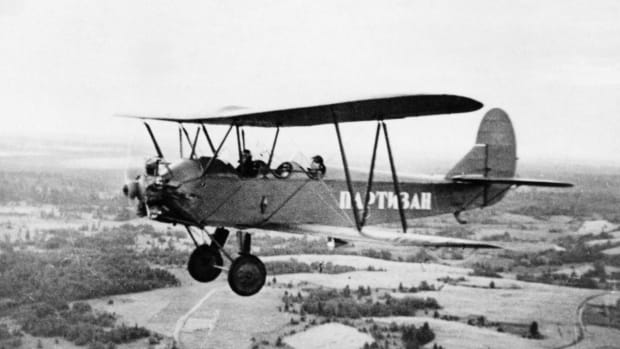
Po-2 in flight- WW2
PO-2 had a number of advantages. Firstly, it was extremely simple and cheap to manufacture and operate, easily repaired, which made its production extremely profitable for the USSR, in which it was the cheapness and simplicity of technology that were of particular importance. Secondly, the plane was very easy to fly, and even an inexperienced pilot could fly it freely. The PO-2 “forgave” the pilot many mistakes that would inevitably lead to an accident on another plane. For this reason, it was the PO-2 that was the main training aircraft of the Soviet Air Force. For example, it was almost impossible to put the car into a tailspin; if the pilot let go of the control rudders, the aircraft began to glide at a rate of descent of 1 meter per second, and if there was a flat surface below, it could land on it on its own. Finally, the PO-2 could land and take to the air literally from an unpaved “patch” – an extremely small place for a run, which made it indispensable for communicating with the partisans. Thirdly, the PO-2 had a low speed and therefore could fly at low altitudes, while faster aircraft risked crashing into hills, trees, and terrain folds. Luftwaffe pilots soon found out that the maize was extremely difficult to shoot down due to two main factors: the PO-2 pilots flew at treetop level, where they were hard to see and hard to reach, and also the stall speed.German fighters such as the Messerschmitt Bf 109 and the Focke-Wulf Fw 190 were similar to the maximum speed of the PO-2, which made it difficult to keep the PO-2 within the range of the fighter’s weapons for sufficient time.
The Po-2 is the only biplane to officially win a battle with a jet aircraft: on April 15, 1953, an American Lockheed F-94 Starfire combat aircraft was lost while trying to intercept a Korean Po-2. The fighter was forced to slow down below 161 km / h when trying to take a position behind the Po-2, which led to its stalling and the “victory” of the biplane.
This made it possible to use the vehicle for attacking and bombing enemy positions, although combat missions were usually carried out at night, since during the day the aircraft became easy prey for enemy fighters and could be shot down by ground fire even from small arms. All these advantages of the PO-2 led to the fact that it was widely used in the USSR Air Force as a night bomber, reconnaissance and communications aircraft.
Night Bomber
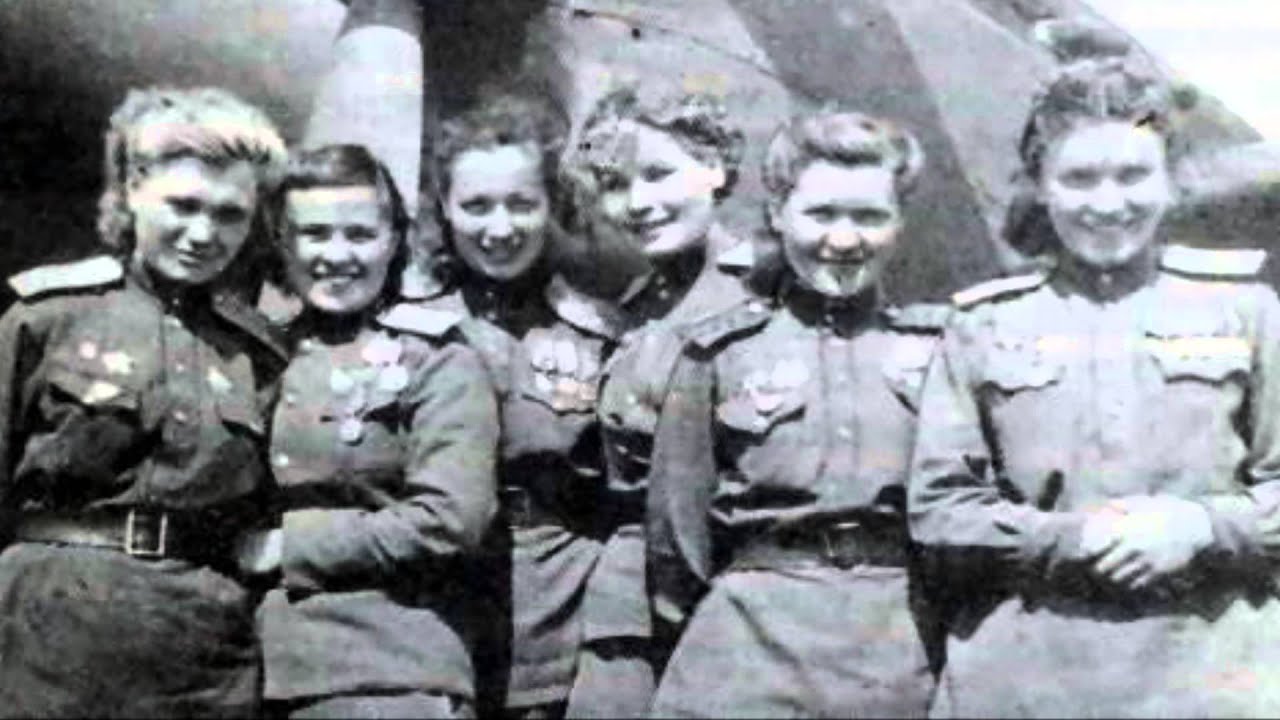 For the first time, the PO-2 was used as a bomber by the pilot of the Civil Air Fleet of the South-Western Air Group P. S. Bevz, who fought near Odessa. It remains unknown whether the aircraft was additionally equipped with bomb weapons, or whether small fragmentation bombs and grenades were dropped manually; and by whom the reset was made – by the pilot himself or by the bombardier, who was in the second cockpit.
For the first time, the PO-2 was used as a bomber by the pilot of the Civil Air Fleet of the South-Western Air Group P. S. Bevz, who fought near Odessa. It remains unknown whether the aircraft was additionally equipped with bomb weapons, or whether small fragmentation bombs and grenades were dropped manually; and by whom the reset was made – by the pilot himself or by the bombardier, who was in the second cockpit.
PO-2s were widely used for the so-called “harassing raids” at night on the front-line positions of enemy troops.
The PO-2 bases lay at a distance of up to 150 km from the front line, and it was most often inconvenient to make intensive flights from them. Therefore, night bomber regiments carried out all combat work from airfields located 20-35 km from the front line. During the day, these sites were empty, and in the evening planes flew over them.
The main munitions dropped from the PO-2 were FAB-100 and FAB-50 high-explosive bombs. Either two “weaves” or 4 bombs of 50 kg caliber were suspended on the bomber. In addition, ampoules filled with a mixture of “KS” were used during bombing. They were loaded into plywood cassettes with a fuse. At a given height, after being dropped, the fuse worked, the cassette opened, and the balls dispersed over a large area, burning everything when they fell to the ground. In addition, incendiary bombs ZABTOOTSH (with thermite balls) and ZAB-50 (with solid fuel) were used. From fragmentation bombs, AO-2.5 were used; AO-10 and since 1943 – AO-25-35, especially active at the beginning of the war and when flying over long distances. From non-lethal ammunition, the SAB-100 lighting bomb and the AGB-100 propaganda bomb were used.
One of the tactics was that light bombers approached the target with engines set to idle or at ultra-low altitude, due to which they remained invisible to enemy air defenses until the very last moment.
In an effort to avoid losses from anti-aircraft fire, a new tactic was tested in the PO-2 regiments. The lead aircraft, led by a pilot with excellent piloting technique, provoked the German air defense to fire. When the searchlights were lit and anti-aircraft guns opened fire on the maneuvering PO-2, the crew of the second bomber entered the air defense positions from the rear, turned off the engine and, going downhill, dropped fragmentation bombs on the projectors and anti-aircraft gunners or fired at them from ShKAS. In 271 NBAA, in addition, an on-board PC installation was developed and used in combat for firing at enemy anti-aircraft weapons. After such a “processing”, the bombers following the leading pair had less difficulty over the target.
Despite the small bomb load, such bombardments had a certain effect. From a low altitude, bombing was carried out with very high accuracy, despite even the dark time of the day and primitive means of aiming. After dropping the bombs, the bomber tried to quickly leave, picking up maximum speed.
The results of the combat activity of the PO-2 were impressive. For example, the navigator of the 97th Guards Night Bomber Aviation Regiment, Lieutenant Hero of the Soviet Union Vasily Dmitrievich Kiz, made 640 sorties, blew up 27 warehouses with fuel and ammunition, destroyed 7 bunkers, an observation post, 168 buildings and structures, destroyed 24 vehicles and 4 planes on the ground. At the same time, individual pilots had more than 800 sorties on their account, and some (Hero of the Soviet Union Irina Fedorovna Sebrova)- more than a thousand.
On particularly intense nights, ground teams provided up to 12 sorties for each PO-2. The number of flights depended on the length of the dark time of the day.
According to the memoirs of Soviet pilots who flew the PO-2, after the factory modification of the aircraft in 1942, the bomb load was significantly increased – up to 250 kg (in some cases – up to 500 kg), flights were sometimes made up to fourteen times a night. “Kaffeemühle” (coffee grinder), “Nähmaschine” (sewing machine, due to the typical sound of the engine) – this is how the Wehrmacht soldiers called the PO-2, which caused a lot of trouble for the enemy in the front line.
In 1943, the number of regiments armed with PO-2 aircraft reached its maximum – up to 70 regiments of night bombers and reconnaissance aircraft operated at the front.
PO-2 could operate in the most adverse weather conditions. So, in February 1944, in extremely difficult weather conditions, PO-2s struck with anti-tank bombs on an enemy armored column near the city of Korsun-Shevchenkovsky. As a result of this air strike, the last attempt of the Germans to break out of the encirclement was thwarted.
An important role was played by the regiments of “night-lighters” (as the commander-in-chief of the 4th air army K. A. Vershinin called them) in the Novorossiysk operation (889th Novorossiysk night light bomber aviation regiment) and all landing operations of 1943-1944 in the Crimea.
Reconnaissance aircraft and communications aircraft
But the main uses, of course, were the functions of a reconnaissance aircraft and a communications aircraft. There was also a sanitary version of the aircraft.
Due to the ability to take off from any platform, the aircraft was widely used when working with partisans. It was actively used to evacuate the population. In February 1943, during the “Osveyskaya tragedy”, up to several dozen passengers per flight (mostly children) were taken out on the PO-2.
In addition, PO-2 aircraft were used to drop small sabotage and reconnaissance groups with a parachute.
The PO-2 was actively used in the Korean War as a light bomber and attack aircraft.
Female Pilots
In the autumn of 1941, the formation of aviation units manned by women began in the USSR Air Force.
One of the women’s air regiments was armed with PO-2 aircraft:
- 46th (“Tamansky”) Guards Night Bomber Aviation Regiment.
23 pilots who fought on the PO-2 were awarded the title Hero of the Soviet Union.
Heroes of the Soviet Union who fought on the PO-2
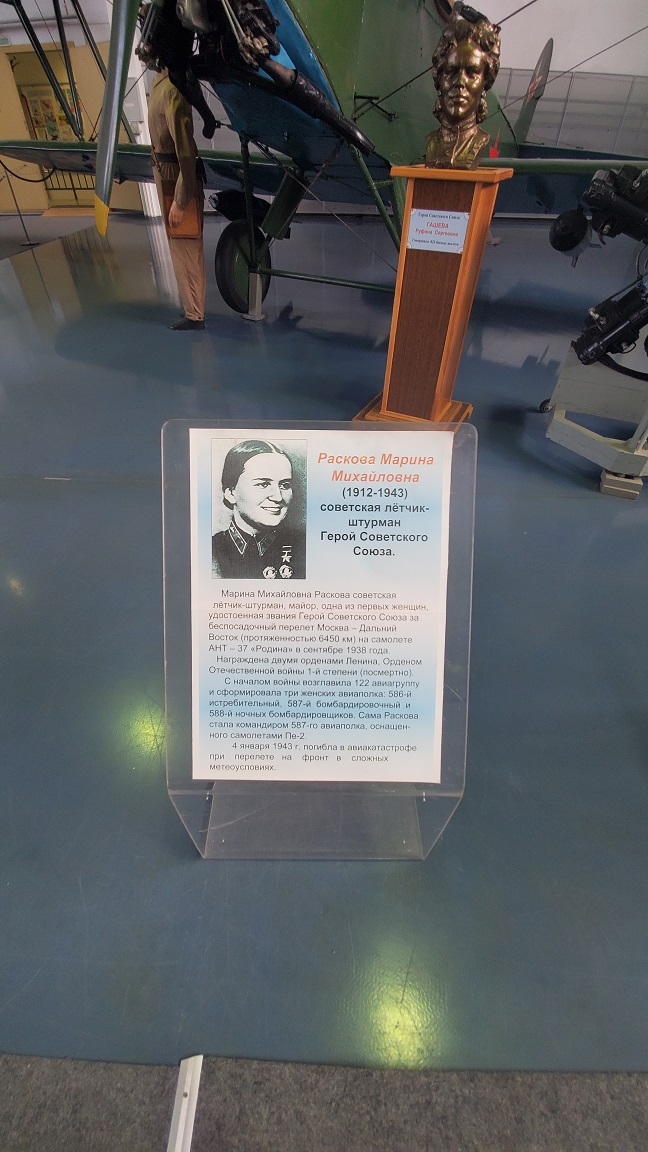
Night Witches
- Aronova Raisa Ermolaevna (1920-1982) Guard Lieutenant, Senior Pilot of the 46th Guards Night Bomber Aviation Taman Red Banner Regiment.
- Bakhvalov Georgy Pavlovich (1914-1974), captain, senior pilot-observer of the 11th separate reconnaissance aviation regiment, began the war in the 128th short-range bomber regiment on the PO-2.
- Belik Vera Lukyanovna (1921-1944) Lieutenant of the Guard, Flight Navigator of the 46th Guards Night Bomber Aviation Taman Red Banner Regiment.
- Gasheva Rufina Sergeevna (1921-2012) senior lieutenant of the guard, navigator of the squadron of the 46th Guards Night Bomber Aviation Taman Red Banner Regiment.
- Gashkov Alexei Veniaminovich (1918-1980) lieutenant, flight navigator of the 386th night bomber aviation regiment.
- Gelman Polina Vladimirovna (1919-2005) senior lieutenant of the guard, head of communications of the aviation squadron of the 46th Guards Night Bomber Aviation Taman Red Banner Regiment.
- Gutorov Mikhail Ivanovich (1919-1997), captain of the guard, squadron commander of the 98th separate corrective reconnaissance aviation regiment.
- Devyataev Mikhail Petrovich (1917-2002), senior lieutenant of the guard, flight commander of the 104th Guards Fighter Aviation Regiment, in 1941-1944 he fought on the PO-2 bomber and sanitary modifications.
- Zhigulenko Evgenia Andreevna (1920-1994) Lieutenant of the Guards, commander of the 46th Guards Night Bomber Aviation Taman Red Banner Regiment.
- Zaevsky Viktor Antonovich (1909-1977) captain, deputy squadron commander of the 392nd Night Bomber Aviation Regiment.
- Zaitsev Alexey Dmitrievich (1914-1995), senior lieutenant, assistant commander of the 707th night bomber aviation regiment.
- Zumbulidze Boris Zakharovich (1905-2000), lieutenant colonel, commander of the 406th night bomber aviation regiment.
- Kiz Vasily Dmitrievich (1922-1996), lieutenant of the guard, flight navigator of the 97th Guards Night Bomber Aviation Regiment.
- Kovalyov Timofey Alekseevich (1918-1981) major, squadron commander of the 15th night bomber aviation regiment.
- Konstantinov Vladimir Fedorovich (1921-1979) senior lieutenant of the guard, flight navigator of the 25th Guards Night Bomber Moscow Aviation Regiment.
- Lagunov Nikolai Ivanovich (1921-2000) major of the guard, flight navigator of the 97th Guards Night Bomber Aviation Regiment.
- Lakatosh Vladimir Pavlovich (1923-2014) junior lieutenant, flight navigator of the 392nd night bomber aviation regiment.
- Flying Alexander Yakovlevich (1908-2002) Colonel, commander of the 734th Night Bomber Aviation Regiment, the 646th Night Bomber Aviation Regiment and the 208th Night Bomber Aviation Division.
- Makarova Tatyana Petrovna (1920-1944) Lieutenant of the Guard, commander of the 46th Guards Night Bomber Aviation Taman Red Banner Regiment.
- Malikov Ilya Antonovich (1921-1990), senior lieutenant, flight commander of the 128th bomber regiment, served in the communications squadron for 2 months.
- Martynov Alexey Petrovich (1920-1994) Guard Captain, Deputy Squadron Commander of the 45th Guards Night Bomber Aviation Warsaw Red Banner Order of Suvorov, 3rd Class Regiment.
- Meklin Natalya Fedorovna (1922-2005) Guard Lieutenant, Senior Pilot of the 46th Guards Night Bomber Aviation Taman Red Banner Regiment.
- Mikhalenko Konstantin Fomich (1920-2011) senior lieutenant of the guard, commander of the 45th guards night bomber aviation Warsaw Red Banner Order of Suvorov 3rd degree regiment.
- Nikolaev Ivan Alexandrovich (1922-2006) Lieutenant of the Guards, flight commander of the 74th Guards Assault Regiment, previously served in the 77th Night Bomber Aviation Regiment.
- Nikulina Evdokia Andreevna (1917-1993) Guard Major, Squadron Commander of the 46th Guards Night Bomber Aviation Taman Red Banner Regiment.
- Novitsky Evgeny Gavrilovich (1912-1997) Guard Captain, Head of the Parachute Service of the 7th Guards Assault Aviation Regiment.
- Nosal Evdokia Ivanovna (1918-1943) junior lieutenant of the guard, deputy squadron commander of the 46th Guards Night Bomber Aviation Taman Red Banner Regiment.
- Ogloblin Ivan Vasilyevich (1921-2011) senior lieutenant of the guard, commander of the 25th guards night bomber Moscow aviation regiment.
- Oprokidnev Boris Konstantinovich (1921-1945) captain, senior pilot-observer of the 511th separate reconnaissance aviation regiment.
- Orlov Pyotr Ivanovich (1923-1945) lieutenant, flight commander of the 707th Danube Red Banner Assault Aviation Regiment, fought on the PO-2 before the regiment was reorganized in 1944.
- Parfyonova Zoya Ivanovna (1920-1993) senior lieutenant of the guard, deputy squadron commander of the 46th guards night bomber aviation Taman Red Banner Regiment.
- Pasko Evdokia Borisovna (1919-2017) senior lieutenant of the guard, navigator of the squadron of the 46th Guards Night Bomber Aviation Taman Red Banner Regiment.
- Popova Nadezhda Vasilievna (1921-2013) Guard captain, deputy squadron commander of the 46th Guards Night Bomber Aviation Taman Red Banner Regiment.
- Popovich Vladimir Trofimovich (1920-1978) senior lieutenant of the guard, squadron commander of the 44th Guards Night Bomber Don Aviation Regiment.
- Putilin Mikhail Tikhonovich (1914-1985), major of the guard, squadron commander of the 74th Guards Assault Aviation Stalingrad Red Banner Regiment, fought for most of the war on PO-2 sanitary and communications modifications.
- Raspopova Nina Maksimovna (1913-2009) senior lieutenant of the guard, commander of the 46th Guards Night Bomber Aviation Taman Red Banner Regiment.
- Rozanova Larisa Nikolaevna (1918-1997) Guard Captain, Navigator of the 46th Guards Night Bomber Aviation Taman Red Banner Regiment.
- Ruban Andrey Frolovich (1914-2007), major, navigator of the 990th Night Bomber Aviation Regiment.
- Rudneva Evgenia Maksimovna (1920-1944) senior lieutenant of the guard, navigator of the 46th Guards Night Bomber Aviation Taman Red Banner Regiment.
- Rykov Leonid Vasilyevich (1921-1988) senior lieutenant of the guard, deputy squadron commander of the 44th Guards Night Bomber Aviation Regiment.
- Ryabova Ekaterina Vasilievna (1921-1974) senior lieutenant of the guard, navigator of the squadron of the 46th guards night bomber aviation Taman Red Banner Regiment.
- Sanfirova Olga Alexandrovna (1917-1944) Guard captain, squadron commander of the 46th Guards Night Bomber Aviation Taman Red Banner Regiment.
- Sebrova Irina Fedorovna (1914-2000) senior lieutenant of the guard, commander of the 46th Guards Night Bomber Aviation Taman Red Banner Regiment.
- Selivanov Evgraf Iosifovich (1911-1945), major of the guard, navigator of the 43rd Guards Assault Regiment, started the war on the PO-2 as part of the 698th Night Bomber Regiment and the 359th Separate Communications Squadron.
- Smirnova Maria Vasilievna (1920-2002) Guard captain, squadron commander of the 46th Guards Night Bomber Aviation Taman Red Banner Regiment.
- Stupishin Mikhail Protasovich (1916-1980), major, navigator of the 198th Volkovysk Red Banner Assault Aviation Regiment, started the war on the PO-2.
- Suponin Dmitry Vladimirovich (1918-1984) senior lieutenant, deputy squadron commander of the 707th night bomber aviation regiment.
- Sukhov Nikolai Dmitrievich (1914-1983) Guard captain, deputy squadron commander of the 44th Guards Night Bomber Aviation Regiment of the Don.
- Syrtlanova Maguba Huseynovna (1912-1971) senior lieutenant of the guard, deputy squadron commander of the 46th guards night bomber aviation Taman Red Banner Regiment.
- Teplov Mikhail Petrovich (1919-2005), senior lieutenant, flight commander of the 638th Night Bomber Aviation Regiment.
- Tomashevsky Ivan Gerasimovich (1918-1994) senior lieutenant of the guard, flight navigator of the 25th Guards Night Bomber Moscow Aviation Regiment.
- Ulyanenko Nina Zakharovna (1923-2005) Guard lieutenant, flight commander of the 46th Guards Night Bomber Aviation Taman Red Banner Regiment.
- Fufachev Vladimir Filippovich (1923-1945), lieutenant, pilot of the 565th assault aviation regiment, started the war on the PO-2.
- Kharitoshkin Alexander Nikolaevich (1922-1988) senior lieutenant of the guard, flight commander of the 23rd Guards Night Bomber Aviation Regiment.
- Khudyakova Antonina Fedorovna (1917-1998) Guards Senior Lieutenant, Deputy Squadron Commander of the 46th Guards Night Bomber Aviation Taman Red Banner Regiment.
- Chechneva Marina Pavlovna (1922-1984) Guard captain, squadron commander of the 46th Guards Night Bomber Aviation Taman Red Banner Regiment.
- Shibanov Viktor Ivanovich (1922-2014) Guard lieutenant, flight commander of the 25th Guards Night Bomber Aviation Moscow Regiment.
- Shipilov Vasily Alekseevich (1908-1987) lieutenant, commander of the ship of the Special Purpose Aviation Group of the 18th Air Army, in 1941-1943 he fought on the PO-2 connected modification as part of the same group.
- Yakovlev Alexander Nikiforovich (1908-1984) lieutenant, flight commander of the 1st Aviation Detachment of the Northern Special Aviation Group of the Civil Air Fleet at the 49th Fighter Aviation Regiment.
Double Heroes
- Vorobyov Ivan Alekseevich (1921-1991), major of the guard, squadron commander of the 76th Guards Assault Aviation Regiment, in 1942-1943 he fought as part of the 25th Guards Night Bomber Moscow Aviation Regiment.
Cavaliers of the highest state awards of the countries of the former USSR, who fought on the PO-2
- Akimova Alexandra Fedorovna (1922-2012) – Hero of Russia (1994), captain of the guard, navigator of the squadron of the 46th Guards Night Bomber Aviation Taman Red Banner Regiment.
- Dospanova Khiuaz Kairovna (1922-2008) – People’s Hero of the Republic of Kazakhstan (2004), senior lieutenant of the guard, navigator of the 46th guards night bomber aviation Taman Red Banner Regiment.
- Leonov Ivan Antonovich (1923-2018) – Hero of Russia (1995), senior lieutenant, pilot of the 33rd separate communications squadron.
- Prokopenko Fedor Fedorovich (1916-2007) – Hero of Russia (1996), colonel of the guard, navigator of the 3rd Guards Fighter Aviation Division, in which he fought on the PO-2 communication modification.
- Salnikov Nikolai Andreevich (1918-2005) – Hero of Russia (1997), colonel of the guard, commander of the 155th Guards Assault Aviation Regiment, from December 1942 to May 1944 fought as part of the 992nd Night Bomber Regiment.
- Semenkov Aleksey Ivanovich (1915-2000) – Hero of Russia (1998), lieutenant general, commander of the 2nd transport aviation Sevastopol regiment, fought in the PO-2 sanitary modification in 1939-1940.
- Sumarokova Tatyana Nikolaevna (1922-1997) – Hero of Russia (1995), lieutenant of the guard, navigator of the squadron of the 46th Guards Night Bomber Aviation Taman Red Banner Regiment.
- Kamanin, Arkady Nikolayevich (1928-1947) – Pioneer Hero, the youngest pilot of World War II, made more than 650 sorties, was awarded the Order of the Red Banner and twice the Order of the Red Star.
Operator countries
Operator countries
USSR (Air Force, Civil Air Fleet, OSOVIAKHIM).
Finland (Air Force; captured).
Nazi Germany (Luftwaffe; captured).
GDR (aero clubs).
France Fighting France (Air Force).
Hungary (Air Force, civil aviation).
Czechoslovakia (Air Force, civil aviation).
Poland (Air Force, civil aviation; production under license).
Yugoslavia (Air Force, flying clubs; production under license).
NSRA (Air Force).
SR Romania (Air Force, civil aviation, flying clubs).
NRB (Air Force, civil aviation, flying clubs).
China (Air Force, civil aviation, flying clubs).
Mongolian People ‘s Republic (Air Force, civil aviation).
North Korea (Air Force, civil aviation, flying clubs).
Memory
In culture
- Films and songs are dedicated to PO-2 aircraft and their pilots:
- film “Heavenly slug” 1945;
- the film “Fighters” 1939;
- the film “And you will see the sky” 1978 – the film is dedicated to the combat biography of A. Kamanin;
- film “In the sky” Night witches” 1981;
- the film “Only “old men” go into battle” 1973;
- the film “Valery Chkalov” 1941;
- the film “If there is war tomorrow” 1938;
- the film “The Schemer” 1935;
- the film “Pilots” in 1935;
- the film “Pilots” in 1988;
- the film “Night Swallows” 2013;
- the film “Fighters” 2013;
- the song “Three pilots served” (music: V. Solovyov-Sedoy, lyrics: S. Fogelson );
- song “Wooden Plane” (music: V. Berkovsky, lyrics: Y. Vizbor).
- song “Night Witches” by the Swedish rock band Sabaton
- In Mytishchi, a monument was erected to the aircraft. 55°54′12″ N sh. 37°42′53″ E e.
- The USSR Post in 1945 and 1978 issued postage stamps depicting the PO-2 (Po-2) aircraft.
- In 2011, the Bank of Russia issued a 1 ruble silver coin in the History of Russian Aviation series dedicated to the PO-2.
- In the game War Thunder is presented as a rank 1 bomber.
In the Modelling Industry
Prefabricated bench models PO-2 / Po-2 were produced and produced by several companies, including:
- Kovozavody Prostejov (Kopro), Czechoslovakia, scale 1:72, in several variants
- PO “Mir” (“Korpak”), Belarus, scale 1:72 (also sold under the brand name “Modelist” and “IOM-kit”)
- FE Resin, Czech Republic, scale 1:144
- ICM, Ukraine, scale 1:72 and 1:48
- Modelkrak/Jadar, Poland, scale 1:48
- Gavia, Czech Republic, scale 1:48 (also branded as Eduard)
- patterns of a model in the Polish magazine “Mały Modelarz”, No. 11, 1960
- Zvezda, Russia, scale 1:144.


